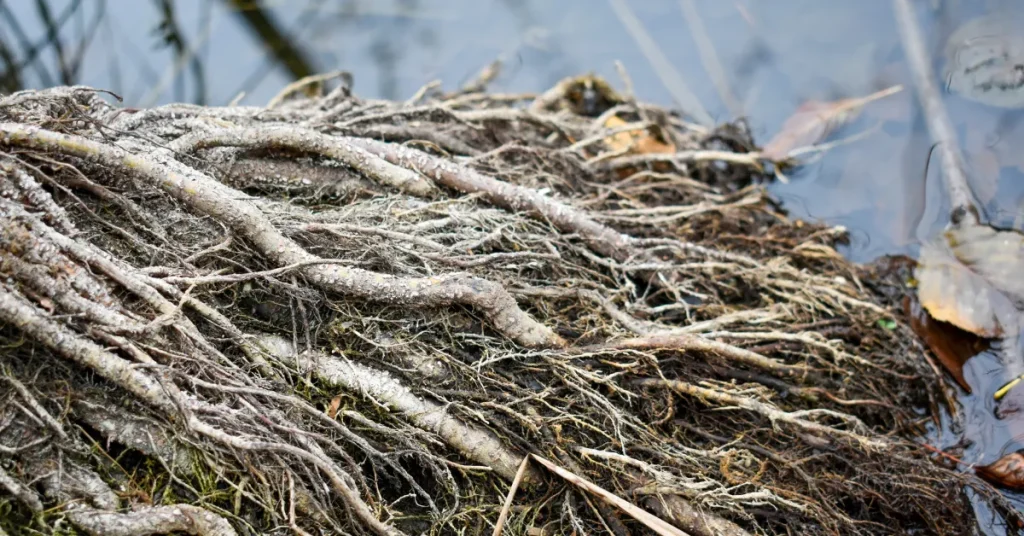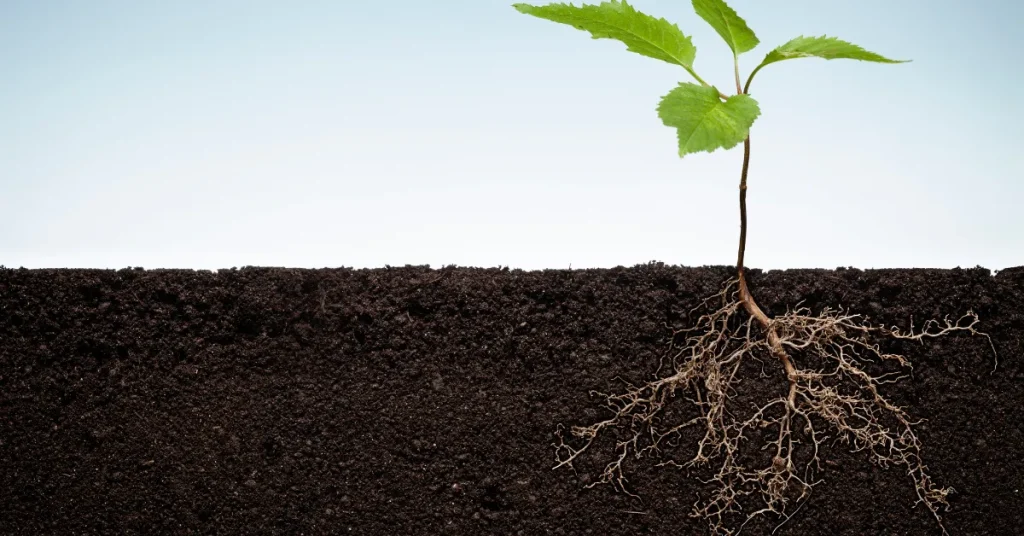Lilac roots typically extend up to 24 inches deep. They may spread wide, often matching the plant’s crown.
Understanding the root depth of lilacs is crucial for gardeners aiming to foster a healthy growth environment for these fragrant shrubs.
With their rooting system not being overly deep, lilacs can thrive in average garden soil, making them accessible to a wide range of planting scenarios.
Their shallow roots favor well-drained, fertile soil, so when planting lilacs, it’s essential to consider the soil quality and provide adequate space for their spread.
This insight helps avoid interference with underground utilities and nearby plantings, ensuring a flourishing garden full of vibrant lilac blooms.

The Hidden World Beneath Your Lilac Bush
The landscape holds secrets just beneath its surface, where roots weave an intricate network vital for plant life. The lilac bush, with its fragrant blooms, is no exception. Its root system is a hidden world of its own, stretching far beyond what the eyes can see.
Decoding Lilac Root Systems
Lilac bushes (Syringa species) captivate with vibrant flowers and sweet scents but their roots tell another story. These roots are shallow and spread out, reaching out in search of nutrients and water.
- Typically, roots extend up to twice the width of the bush’s crown.
- The depth is generally 12 to 18 inches.
- Soil type impacts how far lilac roots will venture.
- Loamy or sandy soils encourage a wider spread.
- Clay soils may lead to a more compact root system.
What Lies Beneath: The Science Of Roots
The magic of lilacs isn’t just in their blooms, but also in the underground labyrinth that supports them. Here’s a glimpse into the science:
| Root Function | Description |
| Absorption | Roots soak up water and minerals. |
| Support | They anchor the bush firmly. |
| Storage | Excess nutrients get stored within roots. |
Under the ground, lilac roots are team players. They interact with soil organisms, such as beneficial fungi, to improve plant health. This symbiotic relationship, known as mycorrhiza, helps lilacs absorb more water and nutrients.
Understanding the root dynamics can aid in better care for your lilac bush, ensuring a healthy life packed with blooms every season.
Penetrating The Depths: How Far Down Lilac Roots Go

Lilac bushes charm us with vibrant blooms and sweet fragrances. Yet, their beauty above ground mirrors a complex system below. Understanding lilac root depth is crucial for gardeners.
It guides planting, watering, and maintenance practices. Let’s dig into the world of lilac roots.
Diving Deep: Average Root Depths
Lilacs have a remarkable root system. On average, these roots spread 12 to 24 inches below the surface. But this is just the start.
The roots can sometimes reach double this depth. They form a strong foundation for the lilac bush. Soil type and age of the plant can change this depth.
Factors That Influence Root Depth
Many elements affect how deep lilac roots go. These include:
- Soil Quality: Looser, well-drained soils encourage deeper rooting.
- Water Availability: Roots may go deeper to find water in dry conditions.
- Age of Lilac: Mature lilacs have deeper roots than young plants.
Lilac Root Behaviors And Growth Patterns
The majesty of lilac bushes in full bloom is a testament to their robust root system. Understanding how deep lilac roots grow helps gardeners nurture these plants for years of spectacular blooms.
Lilac roots have specific behaviors and growth patterns, which are crucial for the plant’s overall health and vitality.
Seeking Nutrients: How Roots Grow
Lilacs’ roots reach out in search of water and nutrients. This vigorous pursuit allows them to support lush foliage and vibrant blossoms.
The roots of a lilac generally spread wider than they are deep, often extending up to one and a half times the width of the bush itself.
- Roots remain relatively shallow, seldom going beyond 12-24 inches.
- The bulk of the root system is in the top 12 inches of soil.
- Feeder roots populate the soil’s surface, soaking up moisture and food.
Seasonal Changes And Root Development
With each passing season, lilac roots adapt to changes in weather and soil conditions. In winter, root growth slows as the plant enters dormancy. Roots focus on storage, conserving energy for the spring burst.
As temperatures rise, the root system kicks into high gear – a frenzy of development in preparation for new shoots and flowers.
| Season | Root Activity |
| Spring | Intense growth |
| Summer | Steady expansion |
| Fall | Nutrient accumulation |
| Winter | Dormancy and conservation |
In spring and summer, the roots absorb maximal nutrients and water. This time is vital for the health and growth of lilacs.
During fall, roots get ready for the cold by accumulating essential nutrients that will help the bush survive the frost. By understanding these patterns, gardeners can provide the right care to ensure a thriving lilac bush.
Implications Of Lilac Root Depth For Gardeners
Lilac root depth matters greatly to gardeners. Understanding how deep the roots of these lovely shrubs go can impact everything from plant health to garden design. Let’s delve into how the depth of lilac roots can affect your gardening decisions.
Spacing Considerations For Planting
Proper spacing ensures healthy growth. Lilacs typically have a root system that extends about one to two times the width of the shrub. This spread influences how close you can plant them to other plants or structures.
- Roots need room to expand.
- Shrubs could compete for nutrients if too close.
- Space them at least 5-15 feet apart, depending on the variety.
Managing Roots In Small Spaces
A small garden needs smart planning. Here’s how to handle lilac roots in confined areas:
| Strategy | Benefits |
| Use dwarf varieties | Less root spread |
| Prune regularly | Control root and canopy size |
| Consider root barriers | Prevent root intrusion into unwanted areas |
Note: Avoid planting too close to foundations or pipes. Lilac roots are non-invasive but precautions are key in limited spaces.
Maintaining The Health Of Lilac Roots

Maintaining the health of lilac roots is crucial for the flourishing of these beautiful shrubs. Vibrant blooms and lush foliage stem from a strong and healthy root system.
A deep understanding of lilac root care ensures that these plants thrive and grace your garden with their sweet-scented flowers year after year. Let’s explore the best practices for keeping lilac roots in top condition.
Watering Wisely: Ensuring Optimal Growth
Proper watering is the lifeline for lilacs. Lilac roots prefer consistently moist soil, without being waterlogged. To achieve this balance:
- Check soil moisture weekly.
- Water deeply to encourage deep root development.
- Avoid shallow watering, which can lead to weak roots.
Using mulch also helps to retain soil moisture and keeps the roots cool. In winter, reduce watering as the plant enters dormancy.
Soil And Fertilizer: Feeding The Roots
Soil health directly impacts root health. For lilacs, aim for rich, well-draining soil. Here’s how to maintain soil that feeds the roots:
| Soil Aspect | Consideration |
| pH Level | Lilacs prefer slightly alkaline soil, around pH 6 to 7. |
| Organic Matter | Add compost annually to nourish the roots. |
When it comes to fertilizers, use them sparingly. A balanced 10-10-10 fertilizer applied in early spring can provide nutrients for growth. Over-fertilization can harm the root system and should be avoided.
FAQs About How Deep Are Lilac Roots
How Deep Do Lilac Bush Roots Grow?
Lilac bush roots typically grow about 12 to 24 inches deep. However, extensive lateral roots can stretch outwards up to twice the height of the bush. It’s important to consider this when planning your garden space.
Can Lilac Roots Damage House Foundations?
Lilac roots are not typically aggressive or strong enough to cause damage to house foundations. They tend to grow more horizontally than deep. However, it is always wise to plant them at a safe distance from structures to prevent any potential issues.
Do Lilacs Have Taproots Or Fibrous Roots?
Lilacs have a fibrous root system rather than a single taproot. This network of numerous small roots helps them absorb moisture and nutrients efficiently, but also means they can spread wide, requiring sufficient garden space.
What Is The Best Soil Depth For Planting Lilacs?
The best soil depth for planting lilacs is about 18 to 24 inches. This ensures that the roots have enough room to grow and access to nutrients. Properly prepared soil with good drainage is crucial for healthy lilac growth.
Conclusion
Gardening enthusiasts, take note: lilac root depths vary. Typically, they span 12 to 24 inches. Understanding this helps prevent damage during landscaping.
Proper care ensures healthy, blooming lilacs. Equip yourself with this root knowledge for vibrant gardens.
Resources:
1. https://www.nh.gov/lilacs/lilacs/planting.htm
